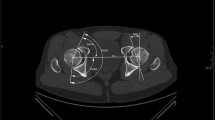Abstract
The purpose was to assess the significance of herniation pits in the femoral neck for radiographic diagnosis of femoroacetabular impingement (FAI). Eighty hips in 62 patients (bilateral in 18) with neutral pelvic orientation were enrolled. Herniation pits were diagnosed when they were located at the anterosuperior femoral neck, close to the physis, and with a diameter of >3 mm. The five radiographic signs of FAI were used: lateral center edge angle (LCE) >39°, acetabular index (AI) ≤0, extrusion index (EI) <25%, acetabular retroversion, and pistol-grip deformity. Patients with radiographs suggesting FAI were retrospectively correlated with their clinical symptoms. Positive radiographic signs were observed in 7 hips with LCE, 7 with AI, and 80 with EI criteria. Only 3 hips out of 80 (3.8%) showed all of the signs. The acetabular retroversion and pistol-grip deformity were seen in 12/80 and 3/80 hips, respectively. The total number of hips that met radiographic criteria for FAI, including pincer type and cam type, was 18 (23%). However, none of these hips were clinically diagnosed with FAI. All symptomatic hips (11/80) presented only with nonspecific pain, and 2 hips out of 11 showed radiographic signs of FAI. The low frequency of positive radiographic signs suggesting FAI with related symptoms among patients with herniation pits suggests that herniation pits have limited significance in the diagnosis of FAI. Therefore it can be concluded that an incidental finding of herniation pits does not necessarily imply a correlation with FAI.





Similar content being viewed by others
Explore related subjects
Discover the latest articles and news from researchers in related subjects, suggested using machine learning.Abbreviations
- FAI:
-
Femoroacetabular impingement
- LCE:
-
Lateral center edge angle
- AI:
-
Acetabular index
- EI:
-
Extrusion index
References
Leunig M, Beck M, Kalhor M, Kim YJ, Werlen S, Ganz R. Fibrocystic changes at anterosuperior femoral neck: prevalence in hips with femoroacetabular impingement. Radiology. 2005;236(1):237–46.
Pitt MJ, Graham AR, Shipman JH, Birkby W. Herniation pit of the femoral neck. AJR Am J Roentgenol. 1982;138(6):1115–21.
Tannast M, Siebenrock KA, Anderson SE. Femoroacetabular impingement: radiographic diagnosis—what the radiologist should know. AJR Am J Roentgenol. 2007;188(6):1540–52.
Kassarjian A, Brisson M, Palmer WE. Femoroacetabular impingement. Eur J Radiol. 2007;63(1):29–35.
Beall DP, Sweet CF, Martin HD, Lastine CL, Grayson DE, Ly JQ, et al. Imaging findings of femoroacetabular impingement syndrome. Skeletal Radiol. 2005;34(11):691–701.
Siebenrock KA, Kalbermatten DF, Ganz R. Effect of pelvic tilt on acetabular retroversion: a study of pelves from cadavers. Clin Orthop Relat Res. 2003;407:241–8.
Tannast M, Zheng G, Anderegg C, Burckhardt K, Langlotz F, Ganz R, et al. Tilt and rotation correction of acetabular version on pelvic radiographs. Clin Orthop Relat Res. 2005;438:182–90.
Kassarjian A, Yoon LS, Belzile E, Connolly SA, Millis MB, Palmer WE. Triad of MR arthrographic findings in patients with cam-type femoroacetabular impingement. Radiology. 2005;236(2):588–92.
Pfirrmann CW, Mengiardi B, Dora C, Kalberer F, Zanetti M, Hodler J. Cam and pincer femoroacetabular impingement: characteristic MR arthrographic findings in 50 patients. Radiology. 2006;240(3):778–85.
James SL, Connell DA, O'Donnell P, Saifuddin A. Femoroacetabular impingement: bone marrow oedema associated with fibrocystic change of the femoral head and neck junction. Clin Radiol. 2007;62(5):472–8.
Ganz R, Parvizi J, Beck M, Leunig M, Notzli H, Siebenrock KA. Femoroacetabular impingement: a cause for osteoarthritis of the hip. Clin Orthop Relat Res. 2003;417:112–20.
Daenen B, Preidler KW, Padmanabhan S, Brossmann J, Tyson R, Goodwin DW, et al. Symptomatic herniation pits of the femoral neck: anatomic and clinical study. AJR Am J Roentgenol. 1997;168(1):149–53.
Acknowledgements
This research was supported by a grant from the Kyung Hee University Research Fund (grant KHU-20071609).
Conflict of interest statement
The authors declare that they have no conflicts of interest, financial or otherwise, to report.
Author information
Authors and Affiliations
Corresponding author
Rights and permissions
About this article
Cite this article
Kim, J.A., Park, J.S., Jin, W. et al. Herniation pits in the femoral neck: a radiographic indicator of femoroacetabular impingement?. Skeletal Radiol 40, 167–172 (2011). https://doi.org/10.1007/s00256-010-0962-9
Received:
Revised:
Accepted:
Published:
Issue Date:
DOI: https://doi.org/10.1007/s00256-010-0962-9




